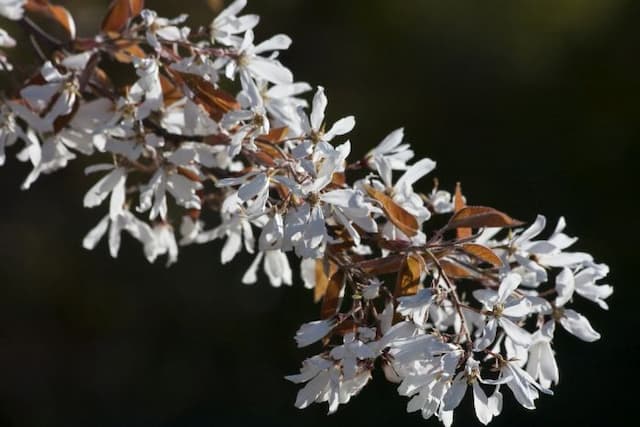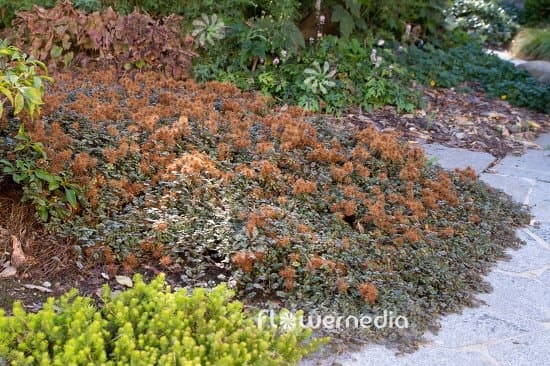Japanese Spiraea Spiraea japonica 'Dart's Red'

ABOUT
The Japanese Spirea 'Dart's Red' is a vibrant and colorful shrub that boasts an array of features which add ornamental value to any landscape. During the growing season, its leaves emerge with a purplish-red hue that eventually transforms into a lively green as the plant matures. When autumn approaches, the foliage once again changes, exhibiting hints of orange and copper that signify the transition into the cooler months. One of the highlights of Japanese Spirea 'Dart's Red' is its abundant clusters of small, deep pink flowers that congregate in flat-topped inflorescences. These floral gatherings bloom profusely in the late spring to early summer, creating a striking contrast against the green leaves, and they continue to provide visual interest throughout the summer. As the flowers fade, they leave behind small brown fruit that may persist into winter. The plant has a mounding habit and is characterized by a profusion of slender, upright to arching branches. These stems are covered in fine hairs when young, adding a delicate texture up close, but as they mature, the branches become woody and more robust. The small oval to lance-shaped leaves are adorned with toothed edges, which further contribute to the textured appearance of this shrub. Overall, the Japanese Spirea 'Dart's Red' is appreciated for its showy blossoms, attractive summer foliage that often carries into the fall, and its easy-going nature in a variety of garden settings.
About this plant
 Names
NamesFamily
Rosaceae.
Synonyms
Japanese Spirea, Japanese Meadowsweet, Maybush.
Common names
Astilbe japonica, Spiraea japonica var. alpina, Spiraea japonica var. bullata, Spiraea japonica var. fortunei, Spiraea japonica 'Albiflora', Spiraea japonica 'Anthony Waterer', Spiraea japonica 'Goldmound', Spiraea japonica 'Little Princess', Spiraea japonica 'Magic Carpet', Spiraea japonica 'Manon'.
 Toxicity
ToxicityTo humans
Japanese meadowsweet is not commonly known to be toxic to humans. There are no well-documented cases of poisoning from this plant in humans, and it is generally considered non-toxic. Therefore, ingesting parts of the plant typically does not result in poisoning symptoms.
To pets
Japanese meadowsweet is also not commonly known to be toxic to pets such as dogs and cats. It is generally considered to be safe for animals, and there is no significant evidence to suggest it has any toxic effects on pets. Thus, ingesting this plant would not be expected to cause poisoning symptoms in pets.
 Characteristics
CharacteristicsLife cycle
Perennials
Foliage type
Deciduous
Color of leaves
Green
Flower color
Pink
Height
2 feet (0.61 meters)
Spread
2 feet (0.61 meters)
Plant type
Shrub
Hardiness zones
4
Native area
Japan
Benefits
 General Benefits
General Benefits- Attractive Foliage: Japanese spirea 'Dart's Red' has vibrant leaves that change color through the seasons, offering visual interest in the garden.
- Floral Display: It produces clusters of deep pink flowers that bloom in late spring to early summer, adding color and attracting pollinators.
- Drought Tolerance: Once established, this plant is relatively drought-tolerant, making it suitable for gardens with lower water availability.
- Low Maintenance: It requires minimal upkeep, making it ideal for gardeners who prefer low-maintenance landscapes.
- Hardiness: This cultivar is resistant to many diseases and pests, which helps ensure its longevity and reduces the need for chemical treatments.
- Compact Size: With its moderate size, it fits well in small gardens or as part of residential landscaping without overwhelming the space.
- Wildlife Support: The flowers of Japanese spirea attract butterflies and other beneficial insects, contributing to local biodiversity.
- Erosion Control: Its root system helps stabilize the soil, making it a good choice for slopes or areas prone to erosion.
- Versatility: It can be used in a variety of landscaping designs, including borders, foundation plantings, and as a specimen plant.
- Seasonal Interest: With flowers in the warmer months and foliage that provides autumn color, it offers multi-seasonal interest.
 Medical Properties
Medical PropertiesThis plant is not used for medical purposes.
 Air-purifying Qualities
Air-purifying QualitiesThis plant is not specifically known for air purifying qualities.
 Other Uses
Other Uses- Photography Background: The lush foliage and vibrant blooms of Japanese spiraea offer a picturesque backdrop for nature photography and garden portraits.
- Educational Tool: Gardeners and educators can use Japanese spiraea to teach about plant life cycles, pollination, and seasonal changes due to its distinct growing patterns.
- Artistic Inspiration: Artists may draw inspiration from the plant’s form, color, and overall beauty, using it as a subject for paintings, drawings, and other types of artistic expression.
- Crafting Dyes: The flowers and leaves, although not commonly used, could potentially be used to create natural dyes for fabrics or crafting projects.
- Erosion Control: When planted in groups, Japanese spiraea can help stabilize soil in areas prone to erosion due to its root network.
- Privacy Screening: With its dense growth habit, Japanese spiraea can be used as a privacy screen in gardens and yards.
- Wildlife Habitat: Japanese spiraea can provide shelter and nesting sites for small birds and beneficial insects within a garden ecosystem.
- Theme Gardens: This plant is suitable for thematic landscaping, such as creating a Japanese-inspired garden space for cultural appreciation.
- Winter Interest: Even after the leaves fall, the structure of Japanese spiraea's branches can add visual interest to a barren winter garden.
- Floral Arrangements: Fresh or dried, the flowers of Japanese spiraea can be used in floral arrangements to add a splash of color to interior settings.
Interesting Facts
 Feng Shui
Feng ShuiThe Japanese spirea is not used in Feng Shui practice.
 Zodiac Sign Compitability
Zodiac Sign CompitabilityThe Japanese spirea is not used in astrology practice.
 Plant Symbolism
Plant Symbolism- Endurance and Strength: The Spiraea japonica, commonly known as Japanese Spirea, is a hardy shrub that can withstand a variety of conditions, symbolizing one's ability to persevere and demonstrate resilience.
- Renaissance and Renewal: As a deciduous plant that blooms vibrant flowers anew each year, Japanese Spirea represents rebirth and the idea of starting afresh.
- Youth and Innocence: The small, pink flowers of the Japanese Spirea are often associated with the light-heartedness and purity of youth.
- Longevity: Japanese Spirea has a long blooming season, which can symbolize a long and prosperous life.
- Welcoming and Hospitality: In some cultures, the lush and attractive blooms of the Japanese Spirea are planted in gardens to signal a welcome to guests, embodying friendliness and warmth.
 Water
WaterJapanese spirea prefers to be watered regularly, especially during dry periods, with an extra soaking during extreme heat. The soil should be kept moist, but not waterlogged. As a general rule, watering about 1 inch per week, either from rainfall or irrigation, is sufficient for healthy growth and blooms. If using a hose or watering can, for a young shrub, approximately 1 to 2 gallons per week should suffice. Adjust the amount according to the weather; water more frequently during long dry spells and less during cool, rainy periods.
 Light
LightJapanese spirea thrives in full sun, meaning it needs at least 6 hours of direct sunlight each day to perform well. However, in hotter climates, it can benefit from some afternoon shade to protect it from the intense heat of the day. Placing it in a location where it will receive ample morning light with some protection from the harsh afternoon sun would be ideal.
 Temperature
TemperatureJapanese spirea is hardy and can withstand a wide range of temperatures, surviving temperatures as low as -20°F to -30°F for short periods. The ideal growing temperature for spirea is between 65°F and 75°F. It grows best in USDA hardiness zones 4 through 8, which correspond to the temperature ranges where it can survive and flourish.
 Pruning
PruningPruning Japanese spirea is important to maintain its shape, remove dead or diseased wood, and encourage a new growth of bright and colorful leaves. The best time to prune is in late winter or early spring, before new growth starts. Annual pruning involves thinning out crowded stems and cutting back the entire shrub to about 6 inches to ensure vigorous foliage and flowering.
 Cleaning
CleaningAs needed
 Soil
SoilJapanese Spirea 'Dart's Red' thrives in well-drained loamy soil with a pH range of 6.0 to 7.0. A mix of garden soil, compost, and peat moss is ideal, ensuring both nutrition and water retention. Mulching helps maintain soil moisture and temperature.
 Repotting
RepottingJapanese Spirea 'Dart's Red' is typically grown outdoors and does not require repotting. It should be planted in the ground or in a large outdoor container that can accommodate its growth for several years.
 Humidity & Misting
Humidity & MistingJapanese Spirea 'Dart's Red' is adaptable to a wide range of humidity levels and does not require specific humidity conditions. It grows well in the average humidity found in outdoor environments.
 Suitable locations
Suitable locationsIndoor
Place in bright indirect light, ensure proper ventilation.
Outdoor
Plant in full sun to partial shade, well-drained soil.
Hardiness zone
4-8 USDA
 Life cycle
Life cycleSpiraea japonica 'Dart's Red', commonly known as Japanese spirea or 'Dart's Red' spirea, begins its life cycle with the germination of seeds in moist, well-drained soil in early spring. After germination, seedlings emerge and the plant enters a vegetative growth stage, producing a compact mound of foliage with new shoots developing from the base. Throughout spring and summer, the mature spirea enters the blooming stage, presenting clusters of small, deep pink flowers that attract pollinators and provide ornamental value. After flowering, it enters a fruiting stage where small capsules containing seeds form, which later disperse to enable the next generation of plants. In autumn, the leaves may change color before they drop as the plant enters a period of dormancy during the colder winter months. With the return of warmer temperatures in spring, the plant breaks dormancy, initiating a new growth cycle.
 Propogation
PropogationPropogation time
Summer
Spiraea japonica 'Dart's Red', commonly known as Japanese spirea, is a popular deciduous shrub often propagated in late winter to early spring, prior to new growth beginning. The most popular method of propagation for this plant is softwood cuttings. This involves taking a stem cutting from new growth that has not yet matured to the point of hardening off, typically around 4 to 6 inches long. The leaves on the lower third of the stem are removed, and the cut end is dipped into a rooting hormone to encourage root development. The prepared cutting is then placed in a well-draining potting mix, ensuring at least one or two nodes (where leaves were removed) are buried in the soil. The environment should be kept humid, often by covering the pot with a plastic bag or placing it in a greenhouse, and the soil should be consistently moist but not soggy. With appropriate care, roots should develop within a few weeks, after which the new plants can be gradually acclimatized to outdoor conditions before planting out.









